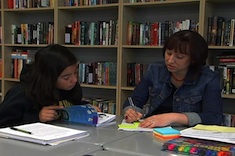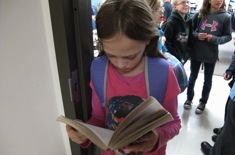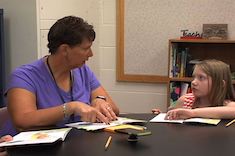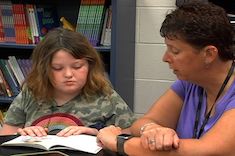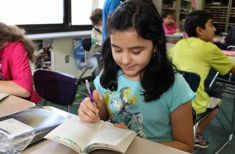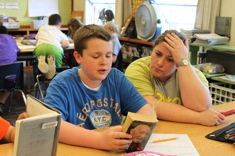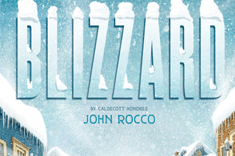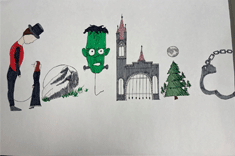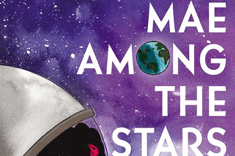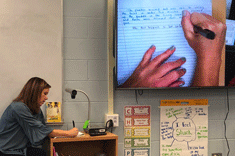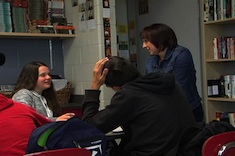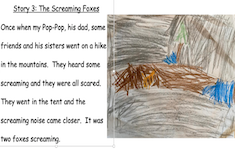Teaching Reading
Our contributors lead reading workshops in classrooms with creative flair. Over the past 12 years, we've filled our site with loads of suggestions, tools, and tips for using engaging books throughout the curriculum to hook kids on reading. Here is where you will find many stories of successful and not-so-successful workshop days, and what we learned from them. We bring these stories to life through hundreds of video examples.
Latest Content
A Case for Graphic Novels as “Real” Reading
Christy Rush-Levine makes a case for the robust nature of reading graphic novels. Included are two downloads: a classroom library permission slip and an initial reader’s notebook entry form.
The Classroom Library: Building Bridges
Cathy Mere presses to help children take the first steps in growing a sustainable reading life that carries beyond the classroom walls. She offers ways to build bridges to the school and public libraries as an essential step.
Guided Reading Part 3: Closure
This is the first guided reading group in September for Cheryl Miller. She concludes the lesson by having students share their understanding of the text and reviewing skills that were practiced. This is the final video in a three-part series.
Guided Reading Part 2: Whisper Reading and Instruction
This is the first guided reading group in September for Cheryl Miller. She continues the lesson by listening to the students whisper read and instructing them as needs arise. This is the second video in a three-part series.
How to Use Students’ Reading Logs as a Formative Literacy Assessment
Matt Renwick reminds us that there is a lot of information available in our classrooms that can inform instruction. Some of it is “hiding in plain sight,” for example reading logs.
Learning to Notice and Analyze Complexities
Gretchen Schroeder supports her high school students to think deeply about the complexities around them, beginning with themselves and pop culture, and then moving to the texts they are reading.
Finding Time for Read Aloud
Katherine Sokolowski makes a case for the importance of reading aloud to secondary students and offers suggestions to make it a reality. She includes a list of five surefire read aloud books for middle school students.
Picture Books to Teach Conflict
Katherine Sokolowski shares a book list that inspires her to teach five different kinds of conflict.
Quick Take: Share Your Reading Struggles
Instructional coach Staci Revere reminds us of the importance of modeling our own reading lives for students, especially the parts where we struggle as readers.
Four Keys to Making Workshop Work
Bitsy Parks reminds us of four key components of running a workshop and offers advice for making workshop work.
One Instructional Strategy Changes a Reading Community: Status of the Class
Mandy Robek reminds us of the power of a status of the class to build a reading community.
Making Time to Listen to Your Readers
Angie Miller reminds us of the importance of making time to listen to student readers so we can make enrichment and instructional adjustments.
Three Meaningful Ways to Incorporate Drawing into English Class
Gretchen Schroeder shares three meaningful ways to incorporate drawing into her high school English classes, and the purpose behind each strategy.
Four Tools for Hosting Online Book Clubs
Matt Renwick leads us to design book clubs where students can continue to grow and connect as readers in online discussions.
Finding Reliable Digital Reading Resources
Cathy Mere shares how to find reliable digital reading resources to pair with print materials to provide strong opportunities for student learning.
Offering Playful Choice to Show Learning
Tammy Mulligan shares her quick thinking when students are bored with book clubs and reminds us all of the importance of offering playful choice for students to show their learning.
Sensible Reasons to Use Student Reading Records
Leigh Anne Eck outlines sensible reasons for students to keep reading records. She considers guidance for book selection, data for teachers, and entry points for reading conferences.
Fairy Tale Study that Needed a Restart
Mandy Robek takes a step back to relaunch a fairy tale study so students can engage in inquiry work in order to discover key characteristics of the genre.
Yoga Poses and Workshop Processes: Honor the Journey
Nawal Qarooni is inspired by her yoga practice to provide a guided reflection to consider if workshop practices are progressing to a transfer of learning.
Finding a Way to Make Heterogeneous Grouping a Reality
Tammy Mulligan shares the vulnerable process of forming heterogeneous groups for book discussions.
Making Connections with Sociograms
Gretchen Schroeder taps into the connections between characters by creating sociograms with her high school students.
COVID Silver Linings: Positive Changes in Teaching Practices
Dana Murphy outlines the teaching practices that she learned from remote teaching and plans to carry with her upon returning to a physical classroom.
Multiple Perspectives Cultivate Empathy
Mark Levine explores ways to cultivate empathy by sharing texts with multiple perspectives on the same event in his middle school social studies class.
When a Library Whispers
Leigh Anne Eck personifies her classroom library by sharing the lessons it whispers when we take the time to listen. This is a practical guide to keeping your classroom library timely and relevant.
Build Reader Identity
Cathy Mere knows that growing skills and strategies readers need is essential, yet helping readers find and grow their identity as readers makes the biggest difference of all.
Nurturing Lifelong Readers
In this beautiful personal essay, Melissa Quimby reminds us to nurture readers through passion conferences, classroom libraries, read-aloud, and independent reading time.
What Do Readers Need?
Christy Rush-Levine offers a close look into the needs of readers by considering engagement, enrichment, and nourishment. She offers three examples of reading conferences with students.
Tips for Creating Shared-Writing Texts Online
Tammy Mulligan offers tips for creating shared-writing texts online.
Class Books Build Readers, Writers, and Community
Bitsy Parks shares the ways in which class books help students work as readers and writers, as well as build a community.
Rethinking “Finding” the Central Idea
Leigh Anne Eck offers a step-by-step guide to help students build a central idea when it is implied in a nonfiction text.
Browse Content By
Type
Category
- Assessment Tools
- Big Fresh Archives
- Booklists
- Choice Numeracy
- Classroom Design
- Common Core
- Community Building
- Conferring
- Content Literacy
- Digital Literacy
- English Language Learners
- Equity
- Family Relations
- Free Samples
- Guiding Groups
- Leadership
- Literacy Coaches
- Mentor Texts
- Minilessons
- New Teacher Mentors
- Podcasts
- Poetry
- Quote Collections
- Reading Strategies
- Self Care
- Struggling and Striving Learners
- Talking and Listening
- Teacher Study Groups
- Teaching Reading
- Teaching Writing
- Word Study and Vocabulary
Author
- Melissa Quimby
- Nawal Qarooni
- Gwen Blumberg
- Julie Cox
- The Lead Learners
- Hannah Tills
- Josie Stewart
- Ruth Metcalfe
- Mallory Messenger
- Becca Burk
- Jodie Bailey
- Vivian Chen
- Mary Brower
- Tiffany Abbott Fuller
- Stephanie Affinito
- Ruth Ayres
- Leigh Anne Eck
- Heather Fisher
- Shari Frost
- Julie Johnson
- Suzy Kaback
- Gigi McAllister
- Shirl McPhillips
- Melanie Meehan
- Cathy Mere
- Debbie Miller
- Tara Barnett and Kate Mills
- Tammy Mulligan
- Dana Murphy
- Bitsy Parks
- David Pittman
- Brenda Power
- Heather Rader
- Matt Renwick
- Mandy Robek
- Christy Rush-Levine
- Gretchen Schroeder
- Jen Schwanke
- Brian Sepe
- Katherine Sokolowski
- Stella Villalba
- Jennifer Vincent
Grade Level
Choice Literacy Membership
Articles
Get full access to all Choice Literacy article content
Videos
Get full access to all Choice Literacy video content
Courses
Access Choice Literacy course curriculum and training

